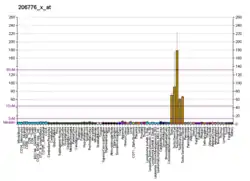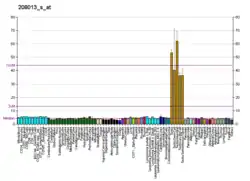| ACRV1 | |||||||||||||||||||||||||||||||||||||||||||||||||||
|---|---|---|---|---|---|---|---|---|---|---|---|---|---|---|---|---|---|---|---|---|---|---|---|---|---|---|---|---|---|---|---|---|---|---|---|---|---|---|---|---|---|---|---|---|---|---|---|---|---|---|---|
| Identifiers | |||||||||||||||||||||||||||||||||||||||||||||||||||
| Aliases | ACRV1, D11S4365, SP-10, SPACA2, acrosomal vesicle protein 1 | ||||||||||||||||||||||||||||||||||||||||||||||||||
| External IDs | OMIM: 102525 MGI: 104590 HomoloGene: 1219 GeneCards: ACRV1 | ||||||||||||||||||||||||||||||||||||||||||||||||||
| |||||||||||||||||||||||||||||||||||||||||||||||||||
| |||||||||||||||||||||||||||||||||||||||||||||||||||
| |||||||||||||||||||||||||||||||||||||||||||||||||||
| |||||||||||||||||||||||||||||||||||||||||||||||||||
| Wikidata | |||||||||||||||||||||||||||||||||||||||||||||||||||
| |||||||||||||||||||||||||||||||||||||||||||||||||||
Acrosomal protein SP-10 is a protein that in humans is encoded by the ACRV1 gene.[5][6][7]
This gene encodes a testis-specific, differentiation antigen, acrosomal vesicle protein 1, that arises within the acrosomal vesicle during spermatogenesis, and is associated with the acrosomal membranes and matrix of mature sperm. This gene consists of 4 exons and its alternative splicing generates multiple distinct transcripts, which encode protein isoforms ranging from 81 to 265 amino acids. The longest transcript is the most abundant, comprising 53-72% of the total acrosomal vesicle protein 1 messages; the second largest transcript comprises 15-32%; the third and the fourth largest transcripts account for 3.4-8.3% and 8.7-12.5%, respectively; and the remaining transcripts combined account for < 1% of the total acrosomal vesicle protein 1 message. It is suggested that phenomena of cryptic splicing and exon skipping occur within this gene. The acrosomal vesicle protein 1 may be involved in sperm-zona binding or penetration, and it is a potential contraceptive vaccine immunogen for humans.[7]
References
- 1 2 3 GRCh38: Ensembl release 89: ENSG00000134940 - Ensembl, May 2017
- 1 2 3 GRCm38: Ensembl release 89: ENSMUSG00000032110 - Ensembl, May 2017
- ↑ "Human PubMed Reference:". National Center for Biotechnology Information, U.S. National Library of Medicine.
- ↑ "Mouse PubMed Reference:". National Center for Biotechnology Information, U.S. National Library of Medicine.
- ↑ Wright RM, John E, Klotz K, Flickinger CJ, Herr JC (Jul 1990). "Cloning and sequencing of cDNAs coding for the human intra-acrosomal antigen SP-10". Biol Reprod. 42 (4): 693–701. doi:10.1095/biolreprod42.4.693. PMID 1693291.
- ↑ Golden WL, von Kap-Herr C, Kurth B, Wright RM, Flickinger CJ, Eddy R, Shows T, Herr JC (Feb 1994). "Refinement of the localization of the gene for human intraacrosomal protein SP-10 (ACRV1) to the junction of bands q23→q24 of chromosome 11 by nonisotopic in situ hybridization". Genomics. 18 (2): 446–9. doi:10.1006/geno.1993.1496. PMID 8288254.
- 1 2 "Entrez Gene: ACRV1 acrosomal vesicle protein 1".
External links
- Human ACRV1 genome location and ACRV1 gene details page in the UCSC Genome Browser.
Further reading
- Herr JC, Klotz K, Shannon J, et al. (1992). "Purification and microsequencing of the intra-acrosomal protein SP-10. Evidence that SP-10 heterogeneity results from endoproteolytic processes". Biol. Reprod. 47 (1): 11–20. doi:10.1095/biolreprod47.1.11. PMID 1637938.
- Homyk M, Anderson DJ, Wolff H, Herr JC (1990). "Differential diagnosis of immature germ cells in semen utilizing monoclonal antibody MHS-10 to the intra-acrosomal antigen SP-10". Fertil. Steril. 53 (2): 323–30. doi:10.1016/s0015-0282(16)53289-0. PMID 2298314.
- Freemerman AJ, Flickinger CJ, Herr JC (1995). "Characterization of alternatively spliced human SP-10 mRNAs". Mol. Reprod. Dev. 41 (1): 100–8. doi:10.1002/mrd.1080410115. PMID 7619499. S2CID 22411156.
- Foster JA, Klotz KL, Flickinger CJ, et al. (1995). "Human SP-10: acrosomal distribution, processing, and fate after the acrosome reaction". Biol. Reprod. 51 (6): 1222–31. doi:10.1095/biolreprod51.6.1222. PMID 7888499.
- Maruyama K, Sugano S (1994). "Oligo-capping: a simple method to replace the cap structure of eukaryotic mRNAs with oligoribonucleotides". Gene. 138 (1–2): 171–4. doi:10.1016/0378-1119(94)90802-8. PMID 8125298.
- Wright RM, Suri AK, Kornreich B, et al. (1993). "Cloning and characterization of the gene coding for the human acrosomal protein SP-10". Biol. Reprod. 49 (2): 316–25. doi:10.1095/biolreprod49.2.316. PMID 8373955.
- Suzuki Y, Yoshitomo-Nakagawa K, Maruyama K, et al. (1997). "Construction and characterization of a full length-enriched and a 5'-end-enriched cDNA library". Gene. 200 (1–2): 149–56. doi:10.1016/S0378-1119(97)00411-3. PMID 9373149.
- Reddi PP, Shore AN, Acharya KK, Herr JC (2002). "Transcriptional regulation of spermiogenesis: insights from the study of the gene encoding the acrosomal protein SP-10". J. Reprod. Immunol. 53 (1–2): 25–36. doi:10.1016/S0165-0378(01)00104-8. PMID 11730901.
- Strausberg RL, Feingold EA, Grouse LH, et al. (2003). "Generation and initial analysis of more than 15,000 full-length human and mouse cDNA sequences". Proc. Natl. Acad. Sci. U.S.A. 99 (26): 16899–903. Bibcode:2002PNAS...9916899M. doi:10.1073/pnas.242603899. PMC 139241. PMID 12477932.
- Gerhard DS, Wagner L, Feingold EA, et al. (2004). "The status, quality, and expansion of the NIH full-length cDNA project: the Mammalian Gene Collection (MGC)". Genome Res. 14 (10B): 2121–7. doi:10.1101/gr.2596504. PMC 528928. PMID 15489334.






